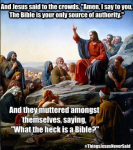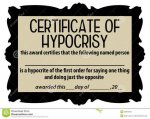2 Timothy 3
[14] But as for you, continue in what you have learned and have firmly believed,
(Tradition)
knowing from whom you learned it
(Magisterium) or Teaching Authority
[15] and how from childhood you have been acquainted with the sacred writings which are able to instruct you for salvation through faith in Christ Jesus.
(Scriptures)
[16] All scripture is inspired by God and profitable for teaching, for reproof, for correction, and for training in righteousness,
[17] that the man of God may be complete, equipped for every good work.
Note verse 14-15. It admonishes Timothy to do three things:
1) Remember what you have learned and firmly believed
(Tradition)
2) Know from whom you learned it
(Magisterium)
3) Know you have the
Scriptures
The Bible on St. Paul's list comes in third, not first. He actually gives here the traditional Catholic teaching on the three sources of sound teaching.
In verse 15 he goes into an excursus on the Bible. This brief excursus emphasizes the value of the Bible and recommends a fourfold method of exegesis. This verse was used in the pre-Reformation Church as a proof text for the Quadriga which was the
standard Catholic approach to the Bible. The Quadriga method used the following four categories:
Literal/Literary
(teaching) - the text as it is written
Analogical
(reproof) - matters of faith
Anagogical
(correction) - matters of hope/prophecy
Moral
(training in righteousness) - matters of charity
The analogical, anagogical and moral senses of the Bible were known collectively as the spiritual senses,
still taught today.
The 'reformers' rejected the BIBLICAL fourfold method of exegesis in favor of a more literal approach,
and ignored 2 Tim 3:16!!!
2 Tim. 3:17 - Paul's reference to the "man of God" who may be complete refers to a clergyman, not a layman. It is an instruction to a bishop of the Church. So, although they use it to prove their case, the passage is not even relevant to most of the faithful.
(2 Tim. 3:16–17).
This passage doesn’t teach formal sufficiency, which excludes a binding, authoritative role for Tradition and Church. Protestants extrapolate onto the text what isn’t there. If we look at the overall context of this passage, we can see that Paul
makes reference to oral Tradition three times (cf. 2 Tim. 1:13–14; 2:2; 3:14). And to use an analogy, let’s examine a similar passage:
(Ephesians. 4:11–15).
If
2 Timothy 3 proves the sole sufficiency of Scripture, then, by analogy,
Ephesians 4 would likewise prove the sufficiency of pastors and teachers for the attainment of Christian perfection. In
Ephesians 4, the C.hristian believer is equipped, built up, brought into unity and mature manhood, and even preserved from doctrinal confusion by means of the teaching function of the Church. This is a far stronger statement of the perfecting of the saints than
2 Timothy 3,
yet it does not even mention Scripture.
So if all non-scriptural elements are excluded in 2 Timothy, then, by analogy, Scripture would logically have to be excluded in Ephesians. It is far more reasonable to recognize that the absence of one or more elements in one passage does not mean that they are nonexistent.
The Church and Scripture are both equally necessary and important for teaching.




